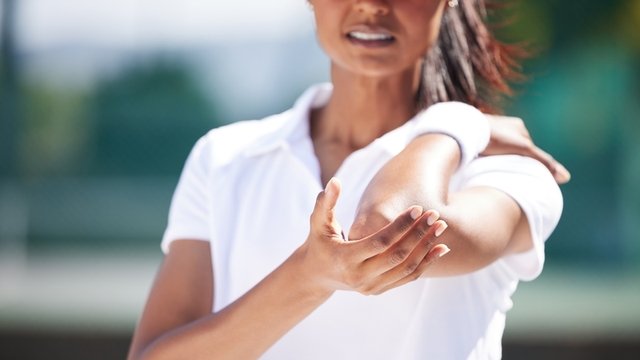

Tennis elbow, medically known as lateral epicondylitis, is an injury that affects many athletes, especially those who practise disciplines involving repetitive arm movements, such as tennis, padel or golf. Although this condition can also arise in work environments, its relationship with sport makes it a relevant issue for those seeking to improve their physical performance and prevent injuries.
If you are interested in specialising in the treatment and prevention of these types of injuries, the Master in Sports Physiotherapy Online at the Escuela Universitaria Real Madrid offers comprehensive training, designed to effectively address the challenges faced by professionals in the sports field.
Definition of tennis elbow
Lateral epicondylitis is an inflammation of the tendons that connect the forearm muscles to the outside of the elbow. This injury is generally caused by repetitive wrist extension movements or intensive use of the forearm muscles.
Although its name suggests that it only affects tennis players, it is also common in padel players, golfers and racket sports players in general.
Causes and symptoms of tennis elbow
The main cause of this condition is the excessive use of the muscles and tendons of the forearm, which causes small tears in the tissues. Risk factors include poor technique, the use of inappropriate and poorly ergonomic equipment and age, as it is more common among people between 30 and 50 years old.
In addition, muscle overload due to training without rest or not warming up properly can lead to repetitive micro-injuries.
Symptoms include pain on the outside of the elbow, which can radiate towards the forearm, weakness when performing simple movements or difficulty holding objects, such as a racket, due to a loss of strength in the affected arm. These signs can worsen if the injury is not treated properly, which highlights the importance of timely diagnosis and treatment.
Recommended treatments for lateral epicondylitis
The treatment of lateral epicondylitis varies according to the severity of the injury, but the most common treatments include:
- Rest and adjustment of sporting activity: reducing or avoiding activities that cause pain.
- Physical therapy: specific exercises to strengthen the forearm muscles.
- Anti-inflammatory drugs: to relieve pain and inflammation.
- Physiotherapy: techniques such as ultrasound or shock wave therapy.
- Corticosteroid injections or platelet-rich plasma: in more serious cases.
If you want to learn more about these treatments, training is key. Programmes such as the Master in Sports Physiotherapy or the Master's Degree in Sports Medicine offer high-level training for professionals dealing with these injuries.
Exercises to treat tennis elbow
Performing specific exercises can be key in the recovery from the injury and in the return to play process, that is, the safe return to sports activity. Some examples are:
- Wrist stretches: stretch the wrist downwards with the other hand to lengthen the forearm muscles.
- Strengthening the grip: use a rubber ball to improve forearm strength.
- Eccentric exercises: slow, controlled movements to strengthen the tendons.
Remember that these exercises should be carried out under the supervision of a sports rehabilitation specialist.
Prevention of tennis elbow: how can this injury be avoided?
Avoiding lateral epicondylitis requires adopting healthy habits and taking care in the way we perform repetitive activities. In these cases, it is recommended to use ergonomic equipment such as rackets, gloves and other accessories designed to reduce the impact on the tendons. It is also important to learn an appropriate technique from qualified professionals.
In addition, incorporating strengthening exercises and stretching is an excellent strategy for keeping muscles and tendons in good condition. Taking regular breaks during long workouts is another essential practice in the prevention of injuries. This allows the tissues to recover and avoids unnecessary overuse.
The importance of training in sports injuries
Programmes focused on training in sports injuries offer a unique opportunity to specialise in a field in constant evolution. This type of study not only provides advanced tools for the diagnosis and treatment of football injuries or knee injuries, for example, but also includes aspects related to the psychology of recovery. Committing to training at this level is the first step in turning your passion for health and sports into a solid career full of possibilities.
Article published on Feb. 5, 2025